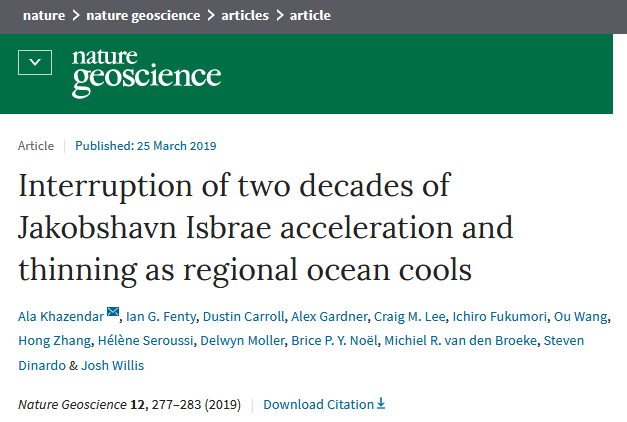Clima. I ghiacciai della Groenlandia invece di sciogliersi stanno aumentando.
Giuseppe Sandro Mela.
2019-03-29.

Il 12 dicembre 2007 il National Geographic News riportava allarmato:
*
«The hot Northern Hemisphere summer sharply increased the rate at which Arctic ice is melting and scientists now believe summer ice could be gone completely within five years.
New Nasa satellite images reveal so much ice has disappeared that an irreversible tipping point has already been reached because of global warming.
The volume of Arctic sea ice at the end of last summer was half what it was four years ago and that the Greenland ice sheet lost almost 19bn tonnes of its volume – more than ever before.
“The Arctic is screaming,” said Mark Serreze, senior scientist at the US government’s Snow and Ice Data Centre in Colorado.
And Nasa climate scientist Jay Zwally said: “At this rate, the Arctic Ocean could be nearly ice-free at the end of summer by 2012, much faster than previous predictions.”
He added: “The Arctic is often cited as the canary in the coal mine for climate warming. Now as a sign of climate warming, the canary has died. It is time to start getting out of the coal mines.”»
* * * * * * * *
Il 2012 è passato e quelle previsioni ‘scientifiche’ si sono rivelate per quello che erano: una bufala.
*
Questo è l’ultimo lavoro pubblicato su Nature Geoscience.

«Jakobshavn Isbrae has been the single largest source of mass loss from the Greenland Ice Sheet over the last 20 years. During that time, it has been retreating, accelerating and thinning. Here we use airborne altimetry and satellite imagery to show that since 2016 Jakobshavn has been re-advancing, slowing and thickening. We link these changes to concurrent cooling of ocean waters in Disko Bay that spill over into Ilulissat Icefjord. Ocean temperatures in the bay’s upper 250 m have cooled to levels not seen since the mid 1980s. Observations and modelling trace the origins of this cooling to anomalous wintertime heat loss in the boundary current that circulates around the southern half of Greenland. Longer time series of ocean temperature, subglacial discharge and glacier variability strongly suggest that ocean-induced melting at the front has continued to influence glacier dynamics after the disintegration of its floating tongue in 2003. We conclude that projections of Jakobshavn’s future contribution to sea-level rise that are based on glacier geometry are insufficient, and that accounting for external forcing is indispensable.»
*
Adesso viene fuori che
«since 2016 Jakobshavn has been re-advancing, slowing and thickening»
* * * * * * * *
Non vorremmo usare parole dure.
Ci basta dire che simili iniziative non dovrebbero essere più a lungo finanziate con denaro del Contribuente e Miss Greta Thunberg dovrebbe tornare a frequentare la scuola, invece di andarsene a zonzo.


Nessun commento:
Posta un commento